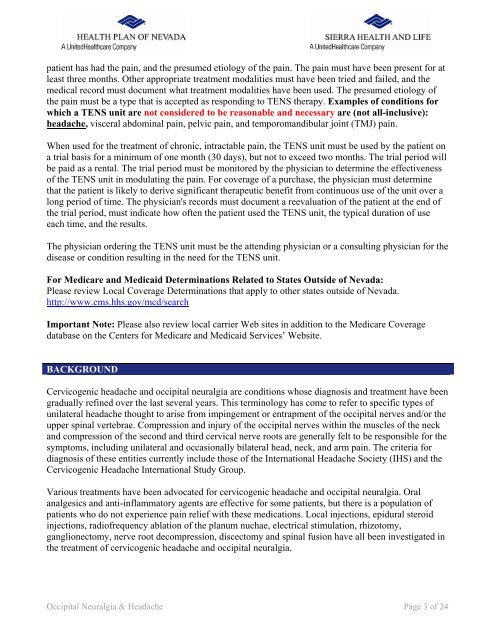occipital neuralgia and cervicogenic, cluster and migraine headaches
occipital neuralgia and cervicogenic, cluster and migraine headaches
occipital neuralgia and cervicogenic, cluster and migraine headaches
Create successful ePaper yourself
Turn your PDF publications into a flip-book with our unique Google optimized e-Paper software.
patient has had the pain, <strong>and</strong> the presumed etiology of the pain. The pain must have been present for at<br />
least three months. Other appropriate treatment modalities must have been tried <strong>and</strong> failed, <strong>and</strong> the<br />
medical record must document what treatment modalities have been used. The presumed etiology of<br />
the pain must be a type that is accepted as responding to TENS therapy. Examples of conditions for<br />
which a TENS unit are not considered to be reasonable <strong>and</strong> necessary are (not all-inclusive):<br />
headache, visceral abdominal pain, pelvic pain, <strong>and</strong> temporom<strong>and</strong>ibular joint (TMJ) pain.<br />
When used for the treatment of chronic, intractable pain, the TENS unit must be used by the patient on<br />
a trial basis for a minimum of one month (30 days), but not to exceed two months. The trial period will<br />
be paid as a rental. The trial period must be monitored by the physician to determine the effectiveness<br />
of the TENS unit in modulating the pain. For coverage of a purchase, the physician must determine<br />
that the patient is likely to derive significant therapeutic benefit from continuous use of the unit over a<br />
long period of time. The physician's records must document a reevaluation of the patient at the end of<br />
the trial period, must indicate how often the patient used the TENS unit, the typical duration of use<br />
each time, <strong>and</strong> the results.<br />
The physician ordering the TENS unit must be the attending physician or a consulting physician for the<br />
disease or condition resulting in the need for the TENS unit.<br />
For Medicare <strong>and</strong> Medicaid Determinations Related to States Outside of Nevada:<br />
Please review Local Coverage Determinations that apply to other states outside of Nevada.<br />
http://www.cms.hhs.gov/mcd/search<br />
Important Note: Please also review local carrier Web sites in addition to the Medicare Coverage<br />
database on the Centers for Medicare <strong>and</strong> Medicaid Services’ Website.<br />
BACKGROUND<br />
Cervicogenic headache <strong>and</strong> <strong>occipital</strong> <strong>neuralgia</strong> are conditions whose diagnosis <strong>and</strong> treatment have been<br />
gradually refined over the last several years. This terminology has come to refer to specific types of<br />
unilateral headache thought to arise from impingement or entrapment of the <strong>occipital</strong> nerves <strong>and</strong>/or the<br />
upper spinal vertebrae. Compression <strong>and</strong> injury of the <strong>occipital</strong> nerves within the muscles of the neck<br />
<strong>and</strong> compression of the second <strong>and</strong> third cervical nerve roots are generally felt to be responsible for the<br />
symptoms, including unilateral <strong>and</strong> occasionally bilateral head, neck, <strong>and</strong> arm pain. The criteria for<br />
diagnosis of these entities currently include those of the International Headache Society (IHS) <strong>and</strong> the<br />
Cervicogenic Headache International Study Group.<br />
Various treatments have been advocated for <strong>cervicogenic</strong> headache <strong>and</strong> <strong>occipital</strong> <strong>neuralgia</strong>. Oral<br />
analgesics <strong>and</strong> anti-inflammatory agents are effective for some patients, but there is a population of<br />
patients who do not experience pain relief with these medications. Local injections, epidural steroid<br />
injections, radiofrequency ablation of the planum nuchae, electrical stimulation, rhizotomy,<br />
ganglionectomy, nerve root decompression, discectomy <strong>and</strong> spinal fusion have all been investigated in<br />
the treatment of <strong>cervicogenic</strong> headache <strong>and</strong> <strong>occipital</strong> <strong>neuralgia</strong>.<br />
Occipital Neuralgia & Headache Page 3 of 24

















